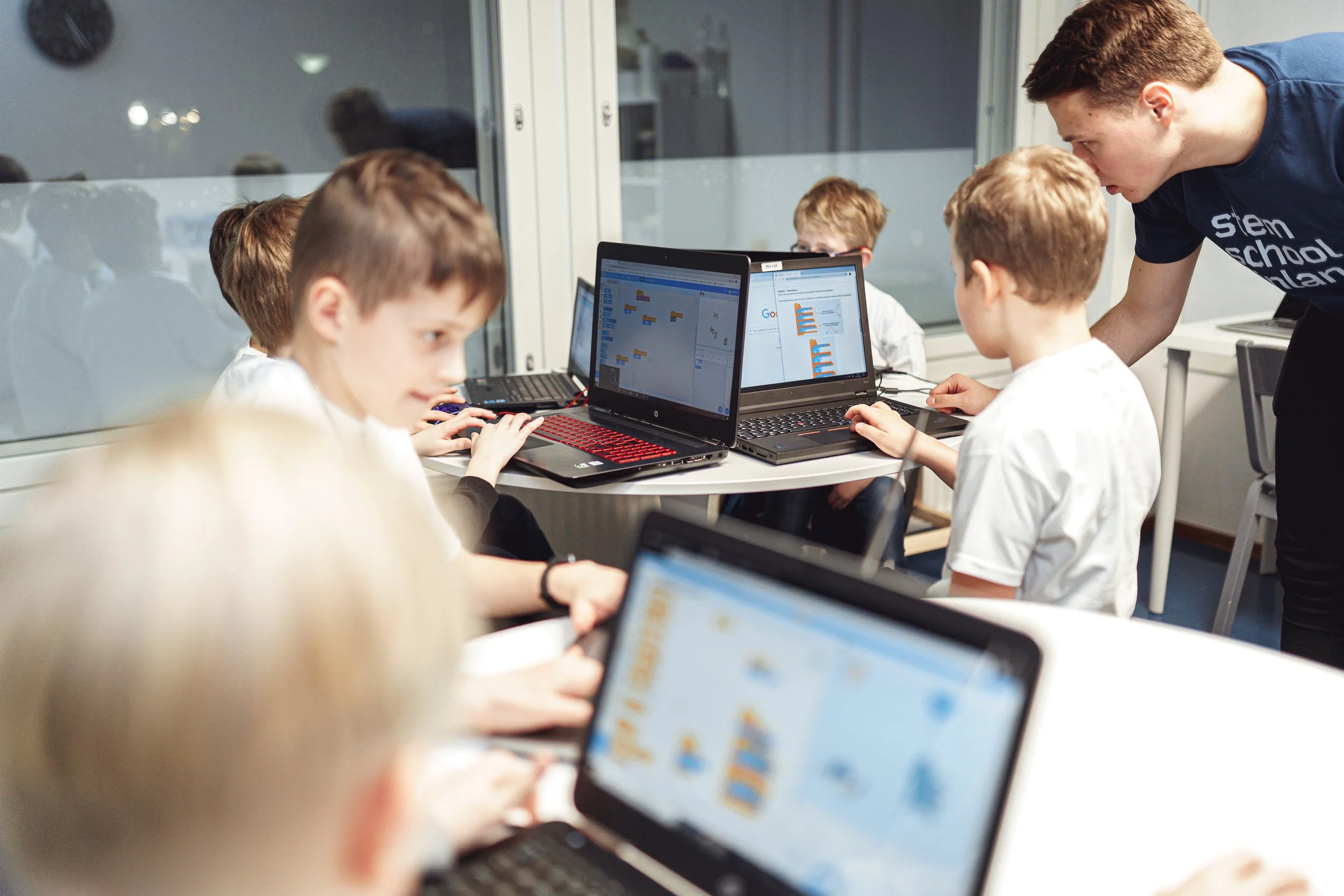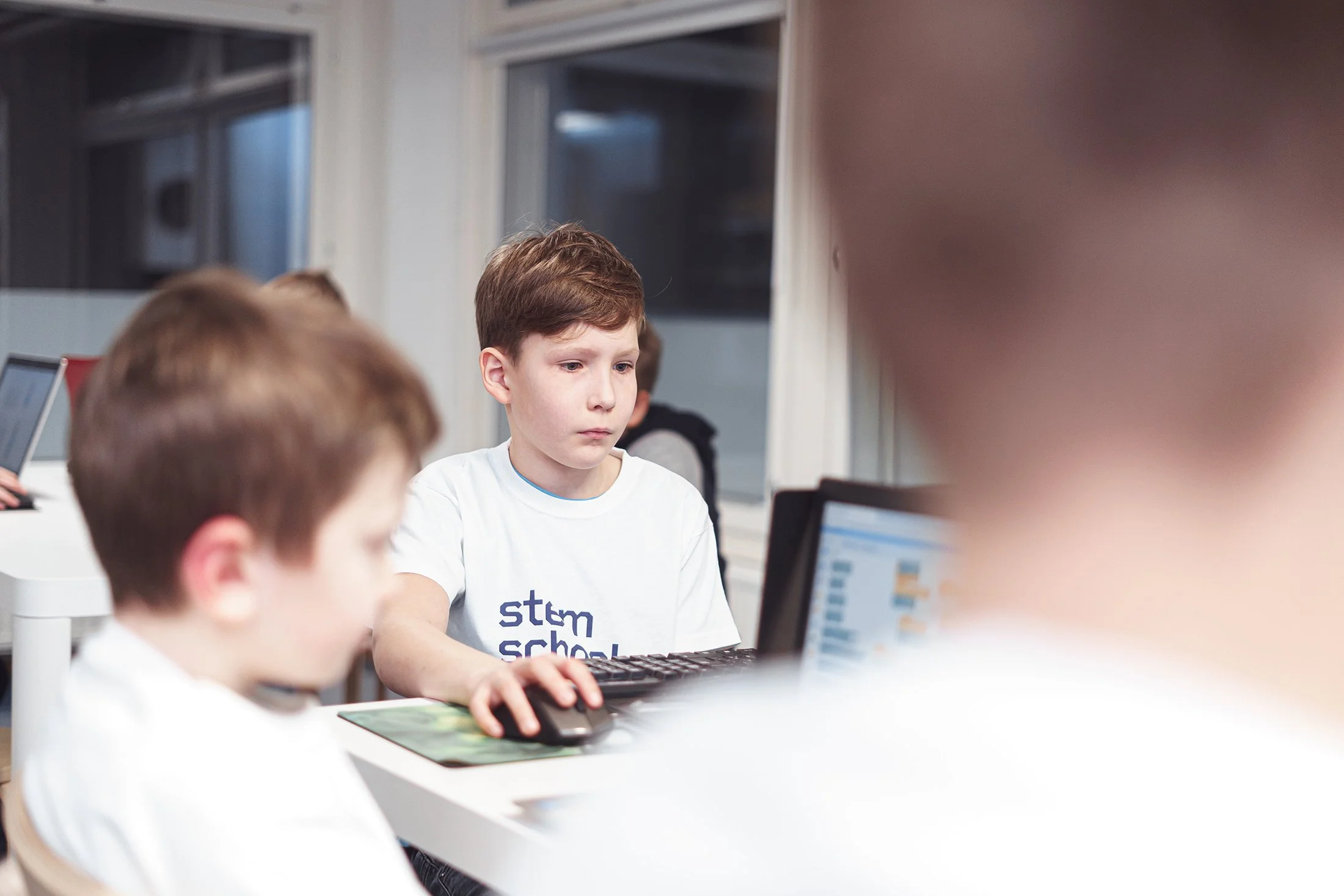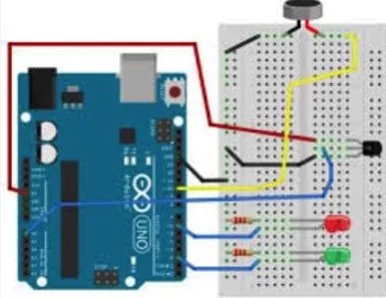Technology
Technology
-

Technology 1
Extent:
2 semesters, 15 lessons in semester, each 60 minutes
Recommended age:
7 to 12 years
Description:
In Technology 1 – module student learns the basics of programming. During this module students are introduced to programming concepts, terminology and basic structures.
Learning objectives:
learn to understand and apply the fundamental principles and concepts of computer science, including abstraction, logic, algorithms and data representation
learn to analyse problems in computational terms, and have repeated practical experience of writing computer programs in order to solve such problems
learn to use visual programming tool
learn to explore with patterns of objects to represent data
learn abstract thinking and problem-solving
learn logical thinking and to use Boolean logic
learn to create different patterns using the same elements
learn to design, modify and follow simple algorithms involving sequences of steps, branching, and iteration
learn to design a basic user interface for a digital system
learn to use different visual programming tools and get an introduction to Python programming language
Implementation:
Each lesson has its own theme. During each lesson there is a short theory of the theme. The goal is that each student learns the basics of the theme, terminology and theory, and is able to implement it in practice using visual programming tool.
Equipment and materials:
Digital/physical STEM lesson plans and videos, each student should have his/her own laptop. Scractch, Microbit simulator and Python turtle – tools are used in this module.
-

Technology 2
Extent:
2 semesters, 15 lessons in semester, each 60 minutes
Recommended age:
7 to 12 years
Description:
In Technology 2 – module student learns more complex concepts of programming. During this module students are introduced to Python and HTML programming languages and concepts.
Learning objectives:
learn to understand and apply the fundamental principles and concepts of computer science, including abstraction, logic, algorithms and data representation
learn to analyse problems in computational terms, and have repeated practical experience of writing computer programs in order to solve such problems
learn to use Python programming tool
learn the basics of Python programming language
learn the basics of HTML programming language
learn to explore with patterns of objects to represent data
learn abstract thinking and problem-solving
learn logical thinking and to use Boolean logic
learn to create different patterns using the same elements
learn to design, modify and follow simple algorithms involving sequences of steps, branching, and iteration
learn to design a basic user interface for a digital system
Implementation:
Each lesson has its own theme. During each lesson there is a short theory of the theme. The goal is that each student learns the basics of the theme, terminology and theory, and is able to implement it in practice using visual programming tool.
Equipment and materials:
Digital/physical STEM lesson plans and videos, each student should have his/her own laptop. Python programming language compiler and HTML editor are used as tools in this module.
-

Technology 3
Extent:
30 oppituntia
Recommended age:
9 to 14 years
Description:
Technology 3 is an advanced group for students who have passed Technology 1 and 2. During the first semester students continue learning Python programming and in use of IoT-device. During second semester students learn the basics of game programming with Python using Pygame libraries.
Learning objectives:
learn more complex programming concepts and structures.
learn to use different programming platforms and tools.
learn advanced logical thinking and problem-solving skills
learn to combine information from different sources and platforms.
learn to design and implement different programs with Python programming language.
learn to use Pygame libraries.
Implementation:
Each lesson has its own theme. During each lesson there is a short theory of the theme. The goal is that each student learns the basics of the theme, terminology and theory, and is able to implement it in practice using Python programming tool and Pygame libraries. Each theme includes exercises. During these semesters students are implementing several programming projects.
Equipment and materials:
Digital/physical STEM lesson plans and videos, each student should have his/her own laptop. Python programming language compiler and Pygame libraries are used as tools in this module.
-

Technology 4 - Game programming
Extent:
2 semesters, 15 lessons in semester, each 60 minutes
Recommended age:
10 to 15 years
Description:
Python programming skills are deepened by programming a two-dimensional adventure game using Pygame. In the first semester, students familiarize themselves with Python dictionary data type by making a role-playing game in the style of Super Nintendo Zelda games and early Pokemon games. At the same time, students learn how to use the Tiled map editor.
In the second semester students acquire deeper the knowledge of Pygame library’s API. The semester give tools to build own 2D game with custom graphics.
Learning objectives:
deepen and expand programming skills
develop logical reasoning ability and problem solving skills and learns to combine information and apply it
learn to design and implement various programs and program structures using Python programming
learn to use the Pygame libraries
learn to program two-dimensional computer games
Implementation:
Each lesson has its own theme, the goal of which is that the child learns the basic theory of the topic and gets to apply it immediately in practice through exercises and tasks. The group does several of its own applied projects.
Equipment and materials:
Digital/physical STEM lesson plans and videos, each student should have his/her own laptop. Python programming language compiler is used as tools in this module.
-

Technology 4 - IoT
Extent:
2 semesters, 15 lessons in semester, each 60 minutes
Recommended age:
10 to 15 years
Description:
Technology 4 IoT is a advanced course where students familiarize themselves with embedded systems and programming of IoT-devices. Students use visual programming tools and also textual programming.
Learning objectives:
learn to use various programming tools
learn logical thinking and problem-solving skills
learn to find, compare and combine information from different sources
learn the basics of IoT-devices and learn to use and program them
learn the basics of embedded systems
deepen Python programming skills
learn to design and implement different programs and program structures
Implementation:
Each lesson has its own theme, the goal of which is that the child learns the basic theory of the topic and gets to apply it immediately in practice through exercises and tasks. The group does several of its own applied projects.
-

Technology 5 - Game programming
Extent:
2 semesters, 15 lessons in semester, each 60 minutes
Recommended age:
11 to 16 years
Description:
Technology 5 is an in-depth follow-up group for students who have passed courses Technology 1 to 4. During this course students delve into game programming and its various aspects.
Learning objectives:
learn the basics and concepts of game programming
know how to use the game programming programming tool appropriately
learn the different stages of game design
develop further logical reasoning and problem-solving skills
learn to combine information and apply it
apply programming skills to an applicable project
learn to use the Unity game engine, which can be used to design and implement games for different game platforms
Implementation:
Each lesson has its own theme, the goal of which is that the child learns the basic theory of the topic and gets to apply it immediately in practice through exercises and tasks. The group plans and implements its own game project.
Equipment and materials:
Digital/physical STEM lesson plans and videos, each student should have his/her own laptop. Python programming language compiler is used as tools in this module.
-

Technology 5 - IoT
Extent:
2 semesters, 15 lessons in semester, each 60 minutes
Recommended age:
11 to 16 years
Description:
Technology 5 is an advanced course where students learn more about embedded systems and IoT-devices and their programming. During this course both visual and textual programming are used.
Learning objectives:
learn to use different visual and textual programming tools
develop logical thinking and problem-solving skills
learn to combine and apply information from different sources
learn the basics of electronics and electronic devices
learn to program embedded devices
learn to use different IoT-devices and program them
deepen knowledge and skills in Python programming
learn to design and implement different programs and program structures
Implementation:
Each lesson has its own theme, the goal of which is that the child learns the basic theory of the topic and gets to apply it immediately in practice through exercises and tasks. The group does several of its own applied projects.
Equipment and materials:
Digital/physical STEM lesson plans and videos, each student should have his/her own laptop. Python programming language compiler is used as tools in this module.
-

Unity 1, 2 and 3
Extent:
2 semesters, 15 lessons in semester, each 60 minutes
Recommended age:
11 to 16 years
Description:
Unity advanced course is an in-depth Unity Game Programming level aimed at
students who have completed courses from Technology 1 to Technology 5. The game engine used during this course is Unity and the programming language is C#. Deeper Unity At the 1st level, during course students combine two-dimensional and three-dimensional graphics. The characters are two-dimensional in the game, but the backgrounds are three-dimensional. Students make an action game that utilizes previous knowledge, but also adds a new perspective to making games. At the same time, students learn about designing a three-dimensional playing field and animating 3D characters.
Learning objectives:
know the basics and concepts of game programming
know how to use the game programming programming tool appropriately
learn the different stages of game design
develop logical reasoning ability and problem solving skills and learn to combine information and apply it
learn to apply programming skills to an applicable project
learn to use the Unity game engine more thoroughly, which can be used to design and implement games
Implementation:
Each lesson has its own theme, the goal of which is that the child learns the basic theory of the topic and gets to apply it immediately in practice through exercises and tasks. The group plans and implements its own game project.
Equipment and materials:
Digital/physical STEM lesson plans and videos, each student should have his/her own laptop. Unity programming language compiler is used as tools in this module.
-

Arduino 1
Extent:
2 semesters, 15 lessons in semester, each 60 minutes
Recommended age:
11 to 16 years
Description:
During this course students deepen their knowledge of embedded systems and learn C++-programming using Arduino UNO microcontroller or the virtual version of it. Students learn to read and write data by using different sensors.
Learning objectives:
know the basics of IoT-programming and C++ programming language
know how to use IoT-devices and programming tools appropriately
learn the phases and process of designing embedded systems
develop logical thinking and problem-solving skills
learn to combine and apply data and information
learn to apply programming skills to an applicable project
Implementation:
Each lesson has its own theme, the goal of which is that the child learns the basic theory of the topic and gets to apply it immediately in practice through exercises and tasks. The students plan and implement a embedded system or IoT-device programming project.
Equipment and materials:
Digital/physical STEM lesson plans and videos, each student should have his/her own laptop. C++ programming language compiler is used as tools in this course. Arduino UNO device or virtual version is used.
“Programming is learned by writing programs.”
— Brian Kernighan
